Kotex New Freedom
towel & pantie ad (date? publication?
U.K.)
Modess "Panti-kini"
(two-band holder to hold pad in crotch;
1960s-1970s, U.S.A.)
Kotex "Panti"
(clasp and band to hold pad in crotch;
1970s?, U.S.A.)
German underpants
(Unterhosen) made from American sugar sack
twine (1945/46)
Various underpants
and panties (and sanitary napkin
belts), 1946-47 (page from Sears, Roebuck
and Co. catalog, U.S.A.)
COMFO-GARD
"pantie" (ad, 1950s?, Malen Mfg. Co.,
U.S.A.)
German brief
panty (German: Slip, Unterhosen) for
menstruation (about 1960)
Various panties,
1960s (part of Personal Digest, Modess,
U.S.A.)


|

Kotex
bikini napkin holder
1960s-1970s?,
Kimberly-Clark, U.S.A
sanitary
napkin, tampon,
pad, belts,
menstruation, women's health, ads
for teenagers,
menstrual period, cycle, panty,
hygiene, bikini
See a 1912 British bikini
before bikinis were bikinis (but
after the Roman ones); scroll to
the bottom of the linked page.
And see early panties
specifically designed for
menstruaion: "Sanitary
Bloomers," 1922 (ad from
Sears, Roebuck and Co. catalog,
U.S.A.).
See more panties in the
column at left and below.
I thank the generous donor,
who has contributed many items
since the start of MUM, in 1994!
|
Below:
The front of the panty on - oh, I'm sorry,
what's your name?
It's actually a plastic mannequin
from the former
museum in my house.
The arrow points to what I think
might have often happened: the thighs
squeeze the pad out of the
holder. See an
enlargement below.
The donor
objects to my presentation of
the pad and panty. See the
comments at the end of the
article.
|
Below:
The rear part.
The blue
arrow points to a napkin tab not tucked
inside the holder.
The red
arrow indicates the same problem
shown at left: the pad working
itself out of the holder.
|
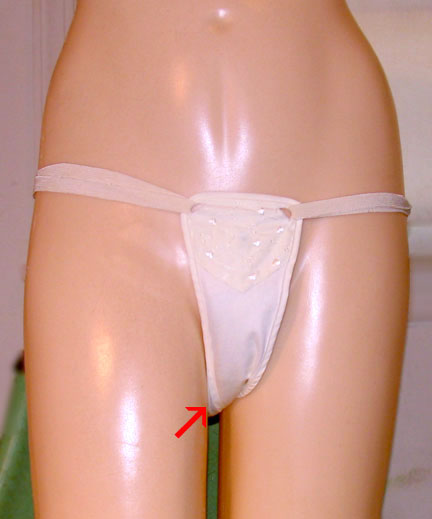 |
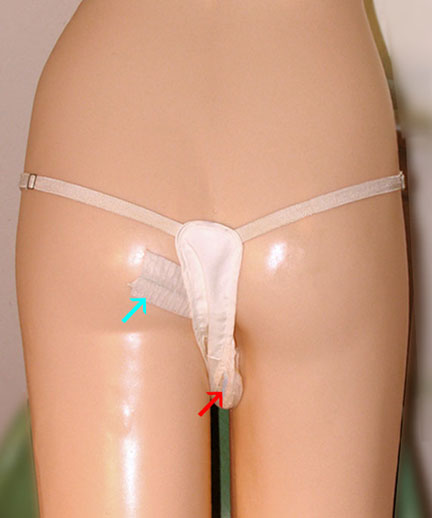 |
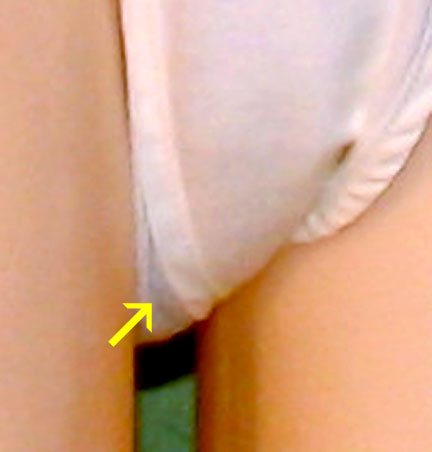 |
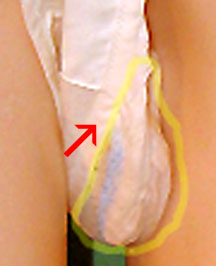 Left:
Yellow indicates the protruding
pad. Left:
Yellow indicates the protruding
pad.
|
Below:
Putting too fine a point on it - close your eyes
if you're easily offended
(but then what are you doing on
this site?) - I show in lurid
detail what happens when the pad (arrow)
gets squashed out.
The pad itself gets twisted,
called roping
in the trade.
|
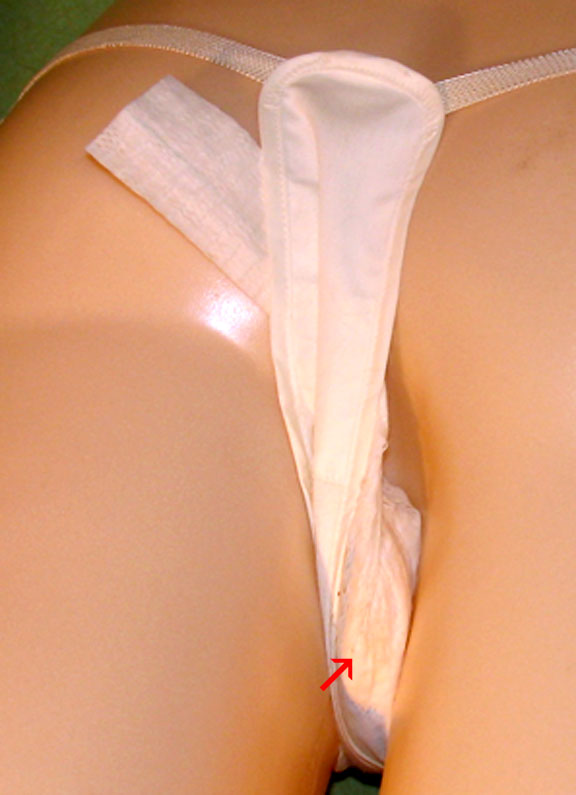 |
You can
open your eyes now ;)
|
Below:
Inside the pad holder: the pad holder flaps
flip up. The tab on the
pad - pads of the time had a long
piece of material (tab) on
either end to fasten to a belt
or in this case to attach to
the pad holder - snaked
through the triangular holder.
Then the wearer pressed the
metal locks together through the
tab to hold the pad in place at
either end.
The yellow
in the lower picture is an
artifact. Everything
should be white.
I did NOT
use a passing elephant for the
background in the last picture!
That's
my art portfolio.
|
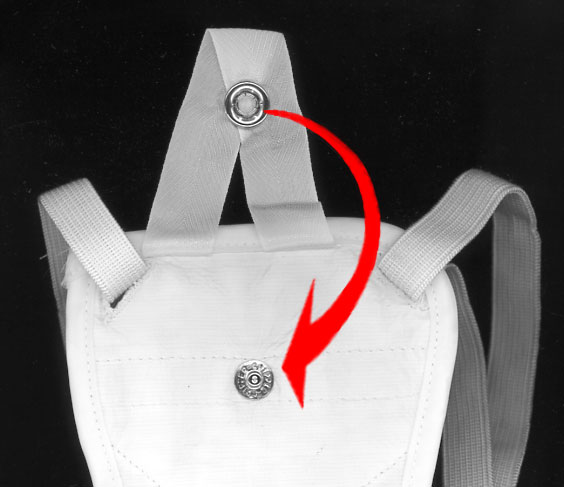 |
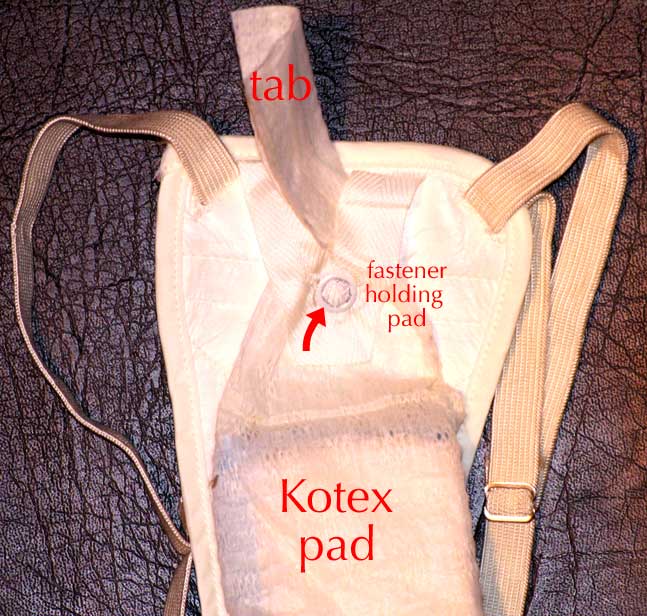 |
|
The donor writes,
I must take issue with some of
your "modeling" of it. The fact
being that the mannequin you're
using is not a "panty" mannequin
with the crotch area between the
legs being excessively narrow as
compared to a live model.
Consequently, the napkin holder
and napkin are excessively
bunched together with the
problem as you present it.
However, this is not true
according to those that have
actually worn it nor would it
have ever been produced had it
fit this poorly.
Rather it is a misleading
presentation of a product that
actually worked very well by
providing a full-way support
under the napkin as opposed to
the tugging and pulling of a
traditional sanitary belt.
Indeed, there is a much greater
tendency for the napkin to
"rope" and twist with being
pulled into place by a sanitary
belt as compared to the
"support" provided by the napkin
holders such as the Kotex
Bikini, the Comfo-Guard, the
Modesty Shield and the
Maxi-Kini's that I also sent. In
this regard check out the Elsayx
Sanitary Belts listed on Ebay.
They obviously do not have the
"bunching problem as you've
presented it.
However, there is also the
right way to put on a Kotex
napkin. As it is being drawn up
into place the sides should be
gently squeezed together into an
inverted "U" shape with the
center of the napkin snugly
against the body.
Unfortunately the cloth-type
"support bands" such as those
just referenced do not readily
permit this. However, this is
just one of the significant
merits of he Maxi-Kini's with
their elastic support band that
I also sent. By comparison the
cloth support bands do not
really shape to the body
contours as the Maxi-Kini's do.
Relative to the merits of the
Kotex Bikini Napkin Holder check
out the posting in the Ladies
Forum of the Kotex website and
the recommendation by Cindy
regarding "Overnight
Protection". Our you can also do
a Google search for the Kotex
Bikini Napkin Holder.
Note, too, that the Modess Demi
Brief/Sanitary Shield is
significant wider than the Kotex
Bikini and would bunch together
even worse per your mannequin.
Also its elastic pad-holding
bands tend to significantly
distort the napkin as compared
to the Kotex Bikini keeping it
flat and smooth with virtually
no distortion whatever.
|
German underpants
(Unterhosen) made from American
sugar sack twine (1945/46)
Various underpants
and panties (and sanitary
napkin belts), 1946-47 (page from
Sears, Roebuck and Co. catalog,
U.S.A.)
COMFO-GARD
"pantie" (ad, 1950s?, Malen Mfg.
Co., U.S.A.)
|
|
© 2010 Harry Finley. It is illegal to
reproduce or distribute any of the work on
this Web site in any manner or medium
without written permission of the author.
Please report suspected violations to hfinley@mum.org
|